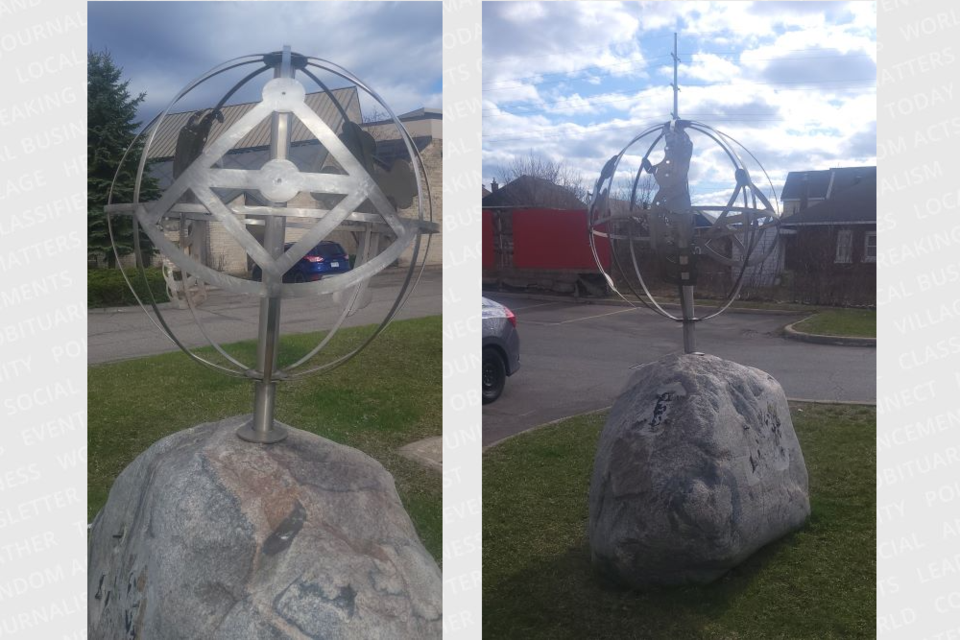From the archives of the Sault Ste. Marie Public Library:
In 1923, a very primitive-looking “prosthetic hand” was found on the Southwest corner of Wellington and Spring Streets. The “hand” is speculated to be one of the oldest historical relics in Ontario, yet not many know its history.
The “prosthesis” is believed to have belonged to Henri (Enrico) de Tonti, an Italian explorer, and Lieutenant for Rene-Robert Cavelier, Sieur de La Salle of the French army. de Tonti had lost his right hand during battle in Sicily when it had been destroyed by a grenade. In 1678, de Tonti sailed to Canada with La Salle and became one of the first European explorers of the Upper Great Lakes.
He was put in charge of the construction of the Griffon, the first ship built on the Great Lakes, in 1679. The ship was built on the Niagara River. Later, La Salle and de Tonti sailed to Kingston and on to the Sault in 1681. It is documented that La Salle and de Tonti sailed to Michilimackinac where de Tonti was left in charge of the post at the fort. Therefore, there is reason to believe that de Tonti was in the Sault and alongside the river system at the time the “prosthetic hand” is thought to have been discarded in the late 17th century.
In 1889, James Curry constructed a house without a cellar on a lot located at the corner of Wellington and Spring Streets. Being that the house was without a cellar, the earth around the property had been logged but not disturbed.
In 1923, Curry’s son-in-law, William Roach, purchased the lot and demolished the original building. The lot had to be further cleared and trees estimated to have been at least 100 years old were taken down. It is under these trees that William Roach discovered the “hand” and a very old brass cross.
The items were found about three feet under the surface, and in an area that had been a river outlet in the past. The size of the trees would indicate that the cross and the “hand” had been in the old river bed since the 1790’s but possibly much earlier. The cross was bent out of shape; it was made of brass and showed Jansenism's influence in that Christ’s arms were raised above his head and not out to his sides. Given that the Jansenism influence had been suppressed by the 1700s, it is possible that the items had been buried and lay undisturbed since the 17th century.
When he made the finding, Roach had instructed his sons to throw the items in amongst the debris at the back of the property. For days it lay there until he sent his sons to the Sault Star office with the prosthetic to be added to its collection of local relics.
The “hand” was soon sent to the Algoma Steel Corporation to test the quality of the iron in it. Algoma Steel’s report indicated that the prosthesis contained material that was 72% iron and had been made using the smelting process, by placing the raw iron on a pile of burning wood. The report said that the “hand” had been cast by pouring the molten iron into a clay mold, making this cast possibly the first to be made in Canada.
There is some discrepancy in this theory though, as it was also believed that the “hand” could have been made through the early Indigenous method of burning wood on top of the ore and then beating the iron into shape while red hot, like the making of an arrowhead. Regardless of its construction, it is not known whether the iron used to make the “hand” was found in Lake Superior or not. Iron was identified in the lake in the 1700s but was not formally mined until 1845.
The city acknowledged the “hand” as a symbol of its history and founding. This acknowledgement is evident in a statue that was erected outside the Sault’s Marconi Club.
The statue, which honours three of the first Italians to have arrived in the area, was erected in 2012 and is located at 450 Albert Street West. The statue is a globe with three items depicted on it, each representing an Italian being honoured. The iron “hand” is featured alongside, a replication of the brass cross and a sextant. The hand is representative of Henri (Enrico) de Tonti, the cross of Father Francesco Bressani, and the sextant of Giovanni Caboto. The statue was designed by Saul-born Enzo Torcoletti and erected by China Steel. The globe is displayed upon a rock donated by Terry Rainone.
Each week, the Sault Ste. Marie Public Library and its Archives provide SooToday readers with a glimpse of the city’s past.
Find out more of what the Public Library has to offer at www.ssmpl.ca and look for more "Remember This?" columns here.
